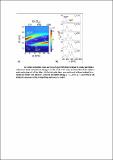Por favor, use este identificador para citar o enlazar a este item:
http://hdl.handle.net/10261/103511COMPARTIR / EXPORTAR:
 SHARE
BASE SHARE
BASE
|
|
| Visualizar otros formatos: MARC | Dublin Core | RDF | ORE | MODS | METS | DIDL | DATACITE | |

| Título: | Transport and sensing in plexcitonic nanocavities |
Autor: | Pérez-González, O. CSIC; Zabala, Nerea CSIC ORCID; Aizpurua, Javier CSIC ORCID | Fecha de publicación: | 2013 | Citación: | ImagineNano 2013 | Resumen: | In the last years fundamental advances have been achieved in the fields of molecular electronics and plasmonics. In particular, the optical properties of plasmonic dimers with different shapes have been deeply studied and explained using exact numerical calculations and hybridization models. Recent experiments, such as the simultaneous measurements of electronic conduction and Raman spectroscopy in molecular junctions, have suggested the possibility of sensing individual molecules, connecting both fields. Boosted by the recent interest in molecular switches, we have studied the optical response of a gold nanoparticle (NP) dimer bridged by a molecular junction with an excitonic transition. The dielectric response of the linker is characterised by a Drude-Lorentz model, which takes into account the excitation energy Eex of the bridging molecule. We connect the NPs with a cylindrical region of radius a mimicking the molecules, and we observe the evolution of the optical properties of the whole system as the bridge becomes wider. Electromagnetic fields and optical extinction cross-sections are obtained from full electrodynamical calculations with a Boundary Element Method (BEM). Figure 1a) shows the evolution of the optical extinction cross-section of a gold NP dimer, with radius R = 50 nm and gap d = 1 nm between them, as the radius of the molecular junction is increased up to a = 25 nm. The excitation energy of the molecules is Eex = 1.51 eV (λ = 820 nm). The Bonding Dimer Plasmon (BDP) and the Bonding Quadrupolar Plasmon (BQP) resonances, arising respectively from the hybridization of the dipolar and quadrupolar modes of the individual NPs, couple to excitons giving rise to new coupled plasmon-exciton modes called plexcitons (see BDP+ and BDP- in Fig. 1a)). Furthermore, the Charge Transfer Plasmon (CTP) resonance, involving a net current through the junction, emerges when the conductance G through the linker is above a threshold value GCTP. The results have been generalized to consider molecular linkers presenting different resonances in the range of Eex = 0.62-3 eV (λ0 = 2000-413 nm). In particular, in Figure 1b) (above), where the radius of the molecular linker is fixed to a = 3nm and its corresponding excitation energy is Eex = 1.24 eV (λ = 1000 nm), the splitting of the BDP plasmon resonance into BDP+ and BDP- plexcitons is also observed. Since the use of metallic NPs as sensors is one of the most promising applications of plasmonics, we have explored the possibilities of the plexciton nanocavity for sensing. Figure 1b) shows the evolution of the optical extinction cross-section of a NP dimer bridged by a molecular linker with radius a = 3nm and excitation energy Eex = 1.24 eV (λex = 1000 nm), as the dielectric response of the embedding medium εd is varied. The BDP+ plexciton mode red-shifts and gains intensity as εd is increased, indicating that it is adequate for standard shiftbased sensing. In contrast, the BDP- plexciton is hardly red-shifted while its intensity is dramatically increased. This indicates that the sensitivity of the BDP- plexciton might be exploited in an alternative way to shift-based sensing, involving the variation of the intensity of the spectral peaks. We believe that the study of this kind of spectral changes in plasmonic nanocavities might lead to a deeper knowledge on plasmonic structures for active devices. | Descripción: | Trabajo presentado al ImagineNano, celebrado en Bilbao (España) del 23 al 26 de Abril de 2013. | Versión del editor: | http://www.imaginenano.com/2013/GENERAL/index.php | URI: | http://hdl.handle.net/10261/103511 |
| Aparece en las colecciones: | (CFM) Comunicaciones congresos |
Ficheros en este ítem:
| Fichero | Descripción | Tamaño | Formato | |
|---|---|---|---|---|
| accesoRestringido.pdf | 15,38 kB | Adobe PDF |  Visualizar/Abrir | |
| Figure 1 a y b.pdf | 142,15 kB | Adobe PDF |  Visualizar/Abrir |
CORE Recommender
Page view(s)
546
checked on 22-abr-2024
Download(s)
125
checked on 22-abr-2024
Google ScholarTM
Check
NOTA: Los ítems de Digital.CSIC están protegidos por copyright, con todos los derechos reservados, a menos que se indique lo contrario.
